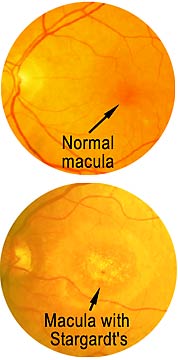| |
Stargardt's
Stargardt's disease (also known as
fundus flavimaculatus) is a type of macular degeneration that typically
surfaces before the age of 20. This disease causes a progressive loss of
central vision of both eyes, but does not affect peripheral vision.
Patients with Stargardt's experience a gradual deterioration of the
retina's cone receptor cells. Cones are concentrated in the macula, and
are responsible for central vision and color. Over time, these diseased
cells cause a blackened hole to form in the central vision, and the
ability to perceive colors is eventually affected.
This disease
is usually an inherited, autosomal recessive disorder. In order to pass
Stargardt's to their children, both parents must carry the recessive
gene for the disease. If both patients are carriers, each of their
children has a 25% chance of developing the disease. There is also a
dominant form of Stargardt's.

SIGNS AND SYMPTOMS
Stargardt's
is a progressive disease. Initially, the symptoms may be mild, but
worsen over time. The progression of Stargardt's varies with the
individual. Studies show that after visual acuity decreases below 20/40,
deterioration may be rapid until visual acuity reaches 20/200. At this
level, the patient's vision typically becomes more stable.
•Blurred vision not correctable with glasses or contact lenses (this is
one of the earliest symptoms)
•Difficulty adapting from bright
sunlight to a dimmer room
•Progressive deterioration of central
vision
•Missing areas of central vision
•Central blind spot
•Diminishing ability to perceive colors
DETECTION AND DIAGNOSIS
In
the early stages of the disease, a child with Stargardt's may have vague
complaints about his or her vision. At this point, the retina may still
appear normal, making it difficult to diagnose with a routine
examination.
Over time, signs of Stargardt's become more evident
with ophthalmoscopy. Upon discovering the clinical signs of Stargardt's,
some physicians may order electrodiagnostic tests to study macular
function, and the patients ability to adapt to dim lighting. Visual
acuity tests, color vision testing, and the Amsler grid are all used to
monitor vision.
If the patient develops leaking vessels in the
macula, fluorescein angiography may be necessary to study the retina's
circulatory system and determine if treatment is necessary.
TREATMENT
Unfortunately, there is no known cure for Stargardt's. Some
patients may require laser treatment to seal leaking blood vessels in
the retina. Laser treatment is performed to reduce lost vision from
leaking vessels; however, it cannot restore vision or halt the
progression of the disease.
Low vision aids are recommended so
patients can better utilize their peripheral and remaining central
vision. These devices include: lamps, large print, particular magnifiers
and telescopes. Contact a local agency for the visually impaired for low
vision and vocational counseling.
In 1997, scientists isolated
the gene that causes Stargardt's. Mutations of this gene, known ABCR,
result in degeneration of the retina's photoreceptor cells.
Understanding the genetics of the disease is critical in developing new
therapies and treatments.
|
|